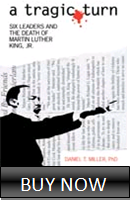A vein of resources lies buried in the past. With my pick-axe in hand, I mined for answers to a particular question:
What does the past say about POTUS 45, Donald J. Trump, winning re-election as president in 2020?
I explored the stories of nine American presidents. Each of them sought re-election to a second consecutive term in the White House. Each won their party’s nomination but lost on Election Day. (I list the nine at the end of this brief essay.)
My findings are below in the form of a six-item checklist. I offer it to you in making your own predictions about 2020. Such a checklist has worth and value, crafted as it is from the passage of time and the actual living of life.
The findings of my research are as follows:
- Unity or disunity. The most important characteristic across the nine presidents is the state of unity or disunity. Each president who lost re-election had already lost something important—namely, the ability to unify the president’s political party. A condition of disunity kills, or very nearly kills, a president’s chances at re-election. Disunity may be expressed differently, whether in the Cabinet, in Congress, in various public settings. The dominant role of unity/disunity as the top factor in failure was one of the biggest surprises in my research. You can’t overstate the role of unity/disunity.
- Loss of energy and momentum. Less clear but no less vital, the decline in momentum and energy in a president’s re-election campaign is another sign of potential failure at the voting booths. Enthusiasm is scant, the feeling of forward motion is gone. This is a feeling or general sense, I’ll freely admit. Nonetheless, it will be palatable. You will notice it, especially in comparison to the opponent’s campaign.
- Crisis defies resolution. A crisis is both at hand and not resolved. This was one of the most interesting findings. I’m referring to the nature of the crises for the nine presidents. An economic crisis wasn’t common to the nine; indeed, only three suffered from economic problems. Similarly, war wasn’t a problem at all; none had a shooting war on their hands. The topic of crisis didn’t really matter. Instead, the key point about crisis was its composition—it had to have two factors: long in time and deep in substance (like a throbbing pain that won’t go away); OR short in time and acute in substance (like a stab wound that produces large amounts of blood). One or the other of these types of crises, when linked to other items on this list, raised major obstacles to successful re-election.
- A leadership trait. The president who failed at re-election was haunted by a particular leadership trait. The trait is longstanding and defining. This trait, while a strength in some situations, was also a weakness in others and had proven so over the course of the president’s life. But as events carried the re-election date closer, the sitting president displayed this trait as a weakness over and over again. The negative effects built up.
- A rival repeated. The sitting president had defeated a particular rival in winning a first term in the White House. Later on, though, that rival reappeared in some form, sometimes again as an opposing candidate or sometimes as the image or symbol embraced by the actual opponent. The rival’s repetition takes on the shape of a dramatic clash evolving over time. It may also have roots in a greater clash of national trends, forces, and issues beyond politics and government. The successful opponent had already appeared quite a while ago to the each of the nine presidents.
- The mid-term is a gateway. The off-year congressional elections act as a gateway, opening a potential path toward the outcome in the forthcoming presidential election. The political parties of nearly all nine presidents suffered losses in the mid-term election preceding the re-election campaign. The range of losses is so wide among the nine, however, that it’s best to view the mid-terms as not determinative. That’s why I termed it as a gateway—a loss to the president’s political party in the mid-terms is a first step through the open gate. Many other steps are required, as for example, with party unity/disunity, a leadership trait, and so on. The mid-terms are one weight and one weight only; other factors will press down harder on the sitting president. When the sitting president’s party loses in the mid-terms, the gate unlocks. Further steps, like those on this list, must then be taken.
I promised to give you the list of nine presidents who won re-nomination but failed at re-election. They are: John Adams, John Quincy Adams, Martin Van Buren, Grover Cleveland, Benjamin Harrison, William Taft, Herbert Hoover, Jimmy Carter, and George H.W. Bush.
Before you go, consider a few things more. First, when you look at the start of three centuries for the Presidency (19th, 20th, and 21st centuries) we are overdue for the appearance of a one-term president. We’re the deepest into a century without a one-termer. Second, only twice in presidential history have we had a trio of consecutive two-term presidencies; the first trio’s streak (Jefferson, Madison, Monroe) was broken by a one-term presidency. Will that be true for the second trio of Clinton, Bush, and Obama? And third, I suggest that the period of time that looks most like our own in innovation, demography, immigration, economy, racial tensions, international relations, and so on is the late 19th and early 20th centuries (1880-1920). That was also the period with the greatest concentration of one-term presidencies of any kind. A kind of historical pressure may be heating up.
Thanks for reading. Feel free to reply with remarks or contact me at dan@historicalsolutions.com. All the best, Dan








